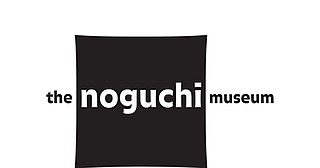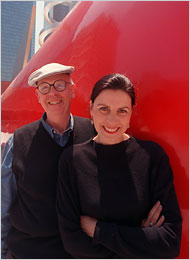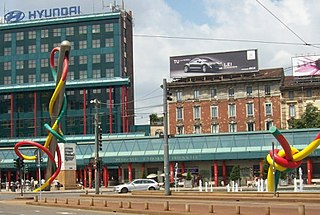
The Noguchi Museum is a museum and sculpture garden at 32-37 Vernon Boulevard in the Long Island City neighborhood of Queens in New York City, designed and created by the Japanese American sculptor Isamu Noguchi (1904–1988). Opening on a limited basis to the public in 1985, the museum and foundation were intended to preserve and display Noguchi's sculptures, architectural models, stage designs, drawings, and furniture designs. The two-story, 24,000 square feet (2,200 m2) museum and sculpture garden, one block from the Socrates Sculpture Park, underwent major renovations in 2004 allowing the museum to stay open year-round.

Isamu Noguchi was an American artist, furniture designer and landscape architect whose artistic career spanned six decades, from the 1920s onward. Known for his sculpture and public artworks, Noguchi also designed stage sets for various Martha Graham productions, and several mass-produced lamps and furniture pieces, some of which are still manufactured and sold.

The Minneapolis Sculpture Garden is an 11-acre (4.5 ha) park in Minneapolis, Minnesota, in the United States. It is located near the Walker Art Center, which operates it in coordination with the Minneapolis Park and Recreation Board. It reopened June 10, 2017, after a reconstruction that resulted with the Walker and Sculpture Garden being unified as one 19-acre campus. It is one of the largest urban sculpture gardens in the country, with 40 permanent art installations and several other temporary pieces that are moved in and out periodically.

Spoonbridge and Cherry is a sculptural fountain designed by Claes Oldenburg and Coosje van Bruggen. It was funded by a $500,000 donation from art collector Frederick R. Weisman and is permanently located in the Minneapolis Sculpture Garden. The piece was completed and installed in 1988 for the Sculpture Garden's opening and consists of a large cherry resting atop a large spoon partially straddling a small pond.

Ellsworth Kelly was an American painter, sculptor, and printmaker associated with hard-edge painting, Color field painting and minimalism. His works demonstrate unassuming techniques emphasizing line, color and form, similar to the work of John McLaughlin and Kenneth Noland. Kelly often employed bright colors. He lived and worked in Spencertown, New York.
Art fabrication describes the process or service of producing large or technically difficult artworks through entities and resources beyond an individual artist's studio. When artists or designers are incapable or choose not to realize their designs or conceptions, they may enlist the assistance of an art fabrication company. Typically, an art fabrication company has access to the resources, specialized machinery and technologies, and labor necessary to execute particularly complex projects. According to a 2018 New York Times article, art fabricators have taken on a greater importance in recent years, as art schools have emphasized ideas and concepts over execution and contemporary artists become less present in their own work.

The Binoculars Building is the common name of Google's Venice campus in Los Angeles, California. Originally known as the Chiat/Day Building, it was built in 1991 for the advertising agency Chiat/Day and designed by architect Frank Gehry. The building has a prominent public artwork entitled Giant Binoculars (1991), designed by artists Claes Oldenburg and Coosje van Bruggen, on its street-facing façade, hence the vernacular name.

The National Gallery of Art Sculpture Garden is the most recent addition to the National Gallery of Art in Washington, D.C. in the United States. It is located in the National Mall between the National Gallery's West Building and the Smithsonian Institution's National Museum of Natural History.

Jeffrey Lynn Koons is an American artist recognized for his work dealing with popular culture and his sculptures depicting everyday objects, including balloon animals produced in stainless steel with mirror-finish surfaces. He lives and works in both New York City and his hometown of York, Pennsylvania. His works have sold for substantial sums, including at least two record auction prices for a work by a living artist: US$58.4 million for Balloon Dog (Orange) in 2013 and US$91.1 million for Rabbit in 2019.

Willard Park is a public park in downtown Cleveland, in the U.S. state of Ohio. The park sits at the northwest corner of East 9th Street and Lakeside Avenue, adjacent to Cleveland City Hall, and is within the boundaries of the Cleveland Mall historic district. It is the location of the public sculpture Free Stamp, and is the home of the original Cleveland Fire Fighters Memorial.

Claes Oldenburg was a Swedish-born American sculptor best known for his public art installations, typically featuring large replicas of everyday objects. Another theme in his work is soft sculpture versions of everyday objects. Many of his works were made in collaboration with his wife, Coosje van Bruggen, who died in 2009; they had been married for 32 years. Oldenburg lived and worked in New York City.

Coosje van Bruggen was a Dutch-born American sculptor, art historian, and critic. She collaborated extensively with her husband, Claes Oldenburg.
Gemini G.E.L., formally Gemini Ltd., is an artists‘ workshop, exhibition space, and publisher of limited edition prints and sculptures, located at 8365 Melrose Avenue in Los Angeles, California.

Clothespin is a weathering steel sculpture by Claes Oldenburg, located at Centre Square, 1500 Market Street, Philadelphia. It is designed to appear as a monumental black clothespin. Oldenburg is noted for his attempts to democratize art with large stylized sculptures of everyday objects, and the location of Clothespin, above Philadelphia's City Hall subway station, allows thousands of commuters to view it on a daily basis. It was commissioned in May 1974 by developer Jack Wolgin as part of the Philadelphia Redevelopment Authority's percent for art program, and was dedicated June 25, 1976.

Lipstick (Ascending) on Caterpillar Tracks is a weathering steel sculpture by Claes Oldenburg. It is located at Morse College Courtyard, at Yale University, in New Haven, Connecticut.
Galerie Max Hetzler is a gallery for contemporary art with locations in Berlin, Paris and London.

Needle, Thread and Knot is a public artwork in two parts by Claes Oldenburg and Coosje van Bruggen in Piazzale Cadorna, Milan, Italy.

Cupid's Span is an outdoor sculpture by married artists Claes Oldenburg and Coosje van Bruggen, installed along the Embarcadero in San Francisco, California, in the United States. The 70-foot (21 m) sculpture, commissioned by Gap Inc. founders Donald and Doris F. Fisher, depicts a partial bow and piece of an arrow.

Mistos is the name given to a group of sculptures by artists Claes Oldenburg and Coosje van Bruggen located in the La Vall d’Hebron neighborhood of Barcelona, Catalonia in Spain. The statue was unveiled in 1992 in anticipation for the 1992 Olympic Games in Barcelona and depicts several matches bending out of a matchbook, with several of the “burned” matches strewn about the nearby intersection. Like most of Oldenburg and van Bruggens’ works, the statues are made of painted steel and concrete.















